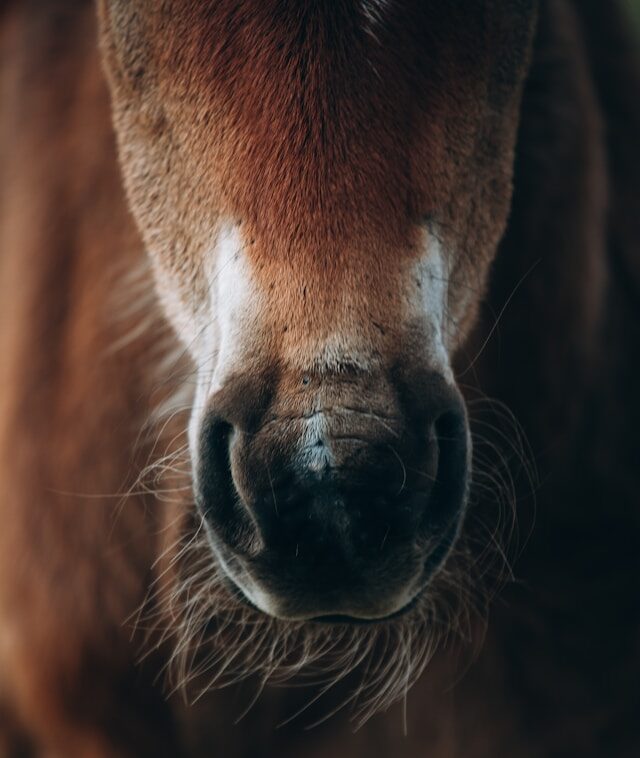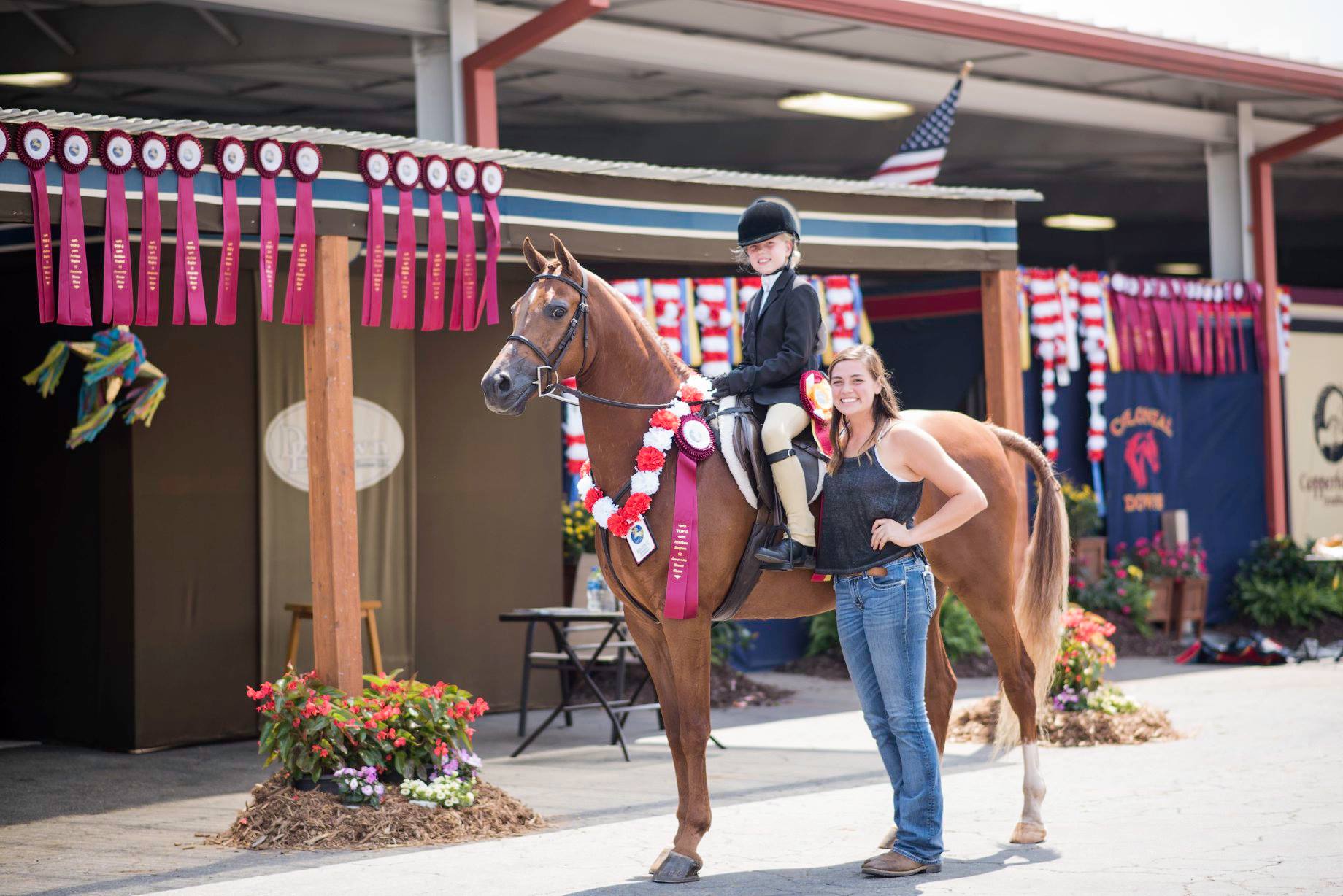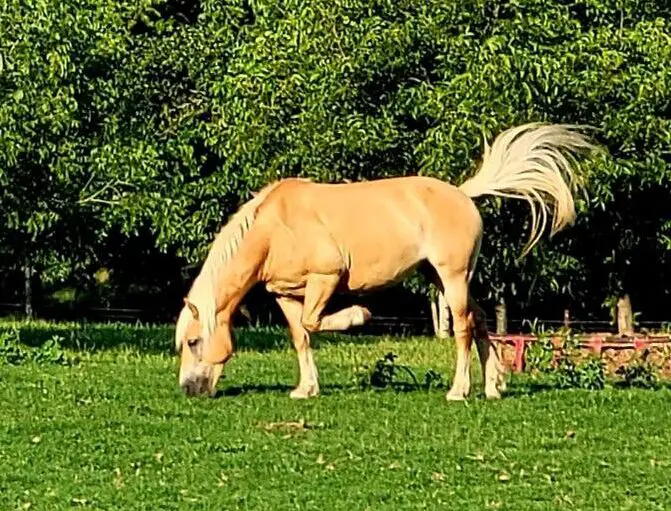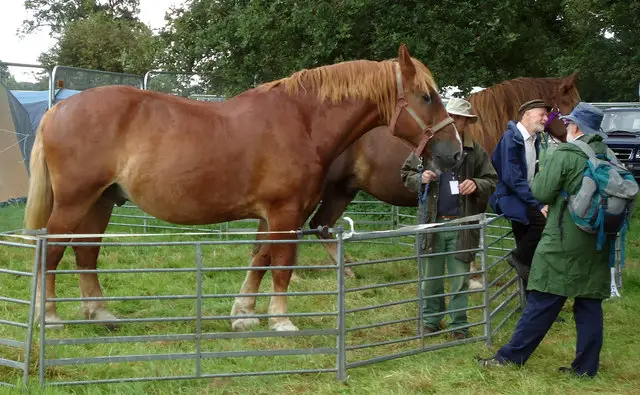Man and horse have partnered for millennium. Horses were instrumental in helping man improve farming, travel, commerce, as well as in waging war. Even the hair on a horse provides not only the horse with protection, his hair too has helped protect man from the elements. Read on to find out how hair on a horse in the form of whiskers is vitally important to their survival. And furthermore, why trimming them is a crime, of sorts.
What is the Hair on a Horse Called
Horses have 3 types of hair on their bodies. Like cats and dogs, the hair covering their bodies is called a coat, however it is never referred to a “fur.” Crowning the horse and streaming behind him like a banner are the mane and tail, made of coarse thick hair. These hairs grow continually. And finally, horses have sensory hairs, that we refer to as horse whiskers. Like whiskers on cats, these sensory hairs perform a number of tasks to protect and improve the survival of the horse.
It is the horse’s whiskers that have recently become controversial. The trimming of horse whiskers is now banned in competing horse across a wide variety of sports on many continents. So, what makes these hairs so special? Let’s dive in to get the skinny on all of the hair on a horse!
- Types of horses and their coats
- What is horse hair called
- What is horsehair
- Why do people shave horses
- Why are horse whiskers clipped
- Why trimming horse whiskers is banned
Horse Coat Types of Cold Blood vs Warmblood vs. Hot Bloods
Cold Bloods
Cold Blooded horses come from the colder regions of Northern Europe. They are cold both in temperament and in their ability to grow a heavy winter coat. These horses tend to be more “plodding” in their nature. Classic Cold Blooded breeds include the Shetland pony, as well as a variety of draft horses, such as the Clydesdale, Percheron, Friesian, and Haflinger. Their calm temperaments make them good pleasure riding and family horses. Their size and heavy bone makes them excellent harness horses. Many of the Draft horses also have “feathers” on their lower legs. This is long, silky hair starting from behind the knee or hock which grows in length until it reaches the fetlock (ankle).

Hot Bloods
In contrast, the Hot Blooded horses, originating from North Africa, are also hot in temperament. As they are from a warm climate, the hot bloods also grow little winter coat. Accordingly, their higher strung temperaments make for good race horses, as they are always ready to go, with a burst of speed. Additionally, they make excellent show jumpers and eventers. Arabians and Thoroughbreds fall into this category.
Warmbloods
Warmbloods are crosses between hot bloods and cold bloods. Popular for dressage as well as show jumping, these versatile horses are are prized for their moderate temperaments, slightly heavier bone, refined heads. And they are priced accordingly. Some of the most expensive horse breeds include Swedish Warmbloods, Dutch Warmblood horses, Oldenburg, Hanoverian horses, Trakhener and Holsteiner. Generally speaking they do not grow heavy winter coats, and typically do not require any winter clipping.

Cutting or Clipping Hair on a Horse
Crowning Hair on a Horse: The Mane and Tail
Horses also have manes and tails, which are made of a heavy protein, keratin, which also composes human hair and nails. The hair from the mane may be slightly lighter and fluffier than the tail hair. These hairs are easily pulled out in small clumps, without distressing the horse. “Pulling” the mane is typically how it is shortened. As horses have few nerve ending in their manes, the hair is shortened, by holding a small clump of the longest hairs in one hand, and teasing the shorter hairs towards the top of the neck. The longer hairs are wrapped around the teasing mane comb, and the hair is easily tugged out. This process achieves a shorter, natural looking mane, which can then be braided for show and parade horses.
When left long and natural, horses use their manes to sweep flies from their neck, by shaking their head and neck.
Banging Tails
The tail hair is typically trimmed or “banged” with scissors to neaten its look. Although it too can be pulled in the same manner as the mane. Depending on the work or sport the horse participates in, it may be trimmed up substantially to prevent it from getting caught in harnesses or on obstacles. Dressage horses tend to keep longer tails. While Eventing horses have their tails banged or trimmed closer to the top of the hock.
The tail hair is strong and flexible. Horses use their tails to flick flies and other pests off of their haunches and sides. Additionally, horse tail hair has been used to create garments for humans for thousands of years. It is harvested by cutting or pulling without any pain or harm to the horse.
What is Horsehair
Horsehair often refers to fabric made from the tail hair, which has been used to make cloth, from horse tail hair, stretched on a loom. The hair is used as the weft of the loom and cotton, silk or wool is woven in as the warp of the loom. This produces a stiffer fabric appropriate for jackets and overcoats.
Why Do People Shave Hair on a Horse
Shaving or clipping horses is done to improve the ascetics of the horse, and more importantly, to keep the horse from becoming overheated during heavy winter workouts and on warm winter days. The Cold Bloods can become very shaggy around their heads and bodies, making them look inelegant. A full-body clip returns the horse to his spring and summer look. The other cuts listed below are intended to reduce the likelihood of sweat building up on those areas prone to sweat, and to aid in cooling off the horse. In colder climates, clipped horses will need to wear horse blankets in the winter. Here are the four types of cuts or clips.
The Full-Body Clip
Clipping the horse completely means head (under jaw) neck, body and legs. This cut is appropriate for horses kept in stalls with blankets for extra cold weather.
The Hunter Clip
The hunter cut, leaves the legs hairy, and trims the head, neck and body. In some instances, people will leave the saddle area untrimmed, to create a natural saddle pad. This cut also requires a blanket for cold winter days.
The Trace Clip
This clip is intended to trim the areas of the horse most prone to sweat. Here the neck, chest and underbelly and mid body as well as a wide strip across the haunches are clipped. Horse with the trace clip may be turned out without a blanket.
The Strip Clip
In the Strip Clip, a strip of hair is clipped from the jawline, down the throat and the under belly. This clip is intended to help the horse cool off after a heavy workout and on warmer winter days.
Do Horses Have Whiskers
Yes! Horses have whiskers, also called sensory hairs or sensory whiskers on their muzzles and above their eyes. They also have softer sensory hairs on the edges and inside their ears.
When I was a teenager, I earned extra spending money clipping horses in the winter, and trimming their muzzles, jaws and ears year round to give them a smart and refined look. Now, as people have begun studying horses from a more natural perspective, new discoveries and thoughts about these sensory hairs have taken root.
The Other Hair on a Horse: Horse Whiskers and Their Purpose
Like cat whiskers, horse whiskers are more deeply implanted than their other hairs, have a richer blood supply and more neural connections. Horses use these whiskers in subtle ways to sense the ground, their surroundings and even fluctuations in airflow.
- The small whiskers above the eyes cause the eyes to automatically blink shut when something even slightly brushes against them. Protecting the eyes is of primary importance for all animals.
- It turns out sensory hairs are important for a horse to protect himself from predators, as well as annoying insects. Because of the horse’s wideset eyes, they have several blind spots.
- Horse blind spots include under his chin and jawline, as well as much of the front of his face. Whiskers let him know where the safe distance from an object begins and ends.
- Horse whiskers are so sensitive that studies suggest they are able to pickup on sound frequencies and vibrational energies, such as those emitted by electric fences.
- The bushy sensory hair around the ears helps to protect the ears from insects and foreign objects when running in a herd.
Why is Cutting Horse Whiskers Illegal
While you won’t go to jail for trimming hair on a horse or his whiskers, certain horse sport organizations have banned the practice for competitors. In many organizations whiskers can only be removed by a veterinarian for medical purposes.
Clipping Horse Whiskers and Its Negative Impact on the Horse
- Studies suggest that clipping whiskers causes stress on the animal. We recognize that as horses who is quick to startle, when surprised by making unexpected contact with doors, rails or fences. This is where their whiskers would have given them a heads up as to the closeness of the object.
- This, in turn, gives rise to increased injuries, without their whiskers warning them of dangers in their blind spots.
- It is suspected that whiskers also help them detect inedible items in their food and when grazing in a pasture.
- Whiskers are an important source of sensory information from the beginning of their lives, by aiding foals with finding their mother and her milk.
Final Thoughts on Whiskers as a Unique Hair on a Horse
In researching this article and seeking images, I found it difficult to find images where the horses whiskers had not been trimmed. It seems the practice is alive and well in the USA and UK.
Organizations that have banned whisker clipping include the The International Equestrian Federation (FEI) and The British Horseracing Authority (BHA). Meanwhile the US Equestrian Federation has fought back, regarding the subjectivity of the clipping of sensory hairs, which they feel may lead to irregular enforcement at competitions.
It seems that the practice of trimming whiskers for a smartly turned out horse is a bad bit of horsemanship. Best to leave their whiskers as they evolved and as nature intended.
References
McGreevy, P. (2012) Equine behaviour. A guide for veterinarians and equine scientists. Second Edition. Elsevier Health Sciences. pg 49.
Jenson, P. (2017) The Ethology of Domestic Animals, Third Edition. pg 182.




